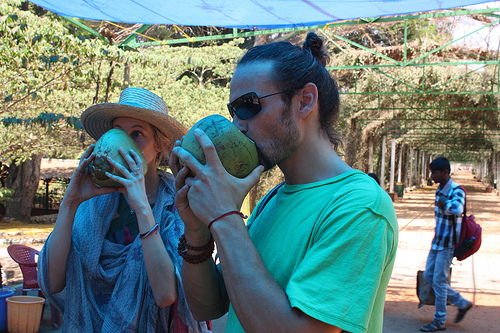Guerilla Ashtangi
Notes from the Field

Mysore, Karnataka, India
It is hot here. At six in the morning when I wake up, the temperature feels close to 80 degrees. Water is running low and power outages are becoming more and more frequent. Joao, my housemate, and a visitor to Mysore every year for the last 10 years, says the summer months are like this, “less water and more darkness.” The few small loads of laundry I did by hand the other day seem frivolous as I peer into the darkness of the empty water tank.
“We have to be watchful,” Joao continues. “Men come from outside to take water from our tank, and Jaya [our house mama] is from a low caste, and they don’t respect her, and they think yogis are all so ‘om shanti’ they will not confront them. But we have to, we need that water.”

I keep my ears open as I get up that night to use the bathroom, and amid the low scuttle of cockroaches I hear trickling water. Is it the men? It is still dark out, and I am feeling not so om shanti — more scared than anything. I go back to bed. In the morning I check, and one of the tanks is full. The trickling was the sounds of city water filling it up.
Both water and om shanti yogis are very much an issue here in Karnataka. Om shanti is a somewhat derisive way of describing yogis who are righteous but nonconfrontational and who prefer to use passive statements such as “It is what it is” instead of actually saying what the truth of the situation is. There are as many of them here in Mysore as there are cows on the road.
One reason for this affective attitude is no doubt because Indian culture is so vastly different, and there are so many layers of corruption, of caste differences, of wealth and poverty, that it is nigh impossible to understand what the right thing to do is in any given situation, and where you, as a foreigner, fit into the scheme of things.
And second, because of ego. Astanga yoga was given to Pattabhi Jois by his guru, the famed grandfather of modern-day yoga, Krishnamacharya. It follows a set series of postures and individuals progress along the sequence as their teacher deems them ready. It is considered to be the original vinyasa-style practice and quite difficult strength-wise. Just to give you an idea, Ashtangis are often referred to as the “marines” of the yoga world. And there is truth to that idea. To see a roomful of accomplished Ashtangis flying through the air, each one in sync with his or her own breath, lifting up to handstand, dropping back to plank, is awe-inspiring. The discipline and training involved in Astanga is unparalleled.
Unfortunately this physical prowess often comes with a dark side. Such intense focus on a linear personal practice, when combined with the Western goal-oriented mentality, leaves little room for creative introspection and instead gives way to a strong new ego, one of the “super yogi.” Super yogis strive to uphold all the principles usually expected of yogis — strict vegetarianism, nonviolence, non-grasping, and generally having a fine and dandy om shanti mentality all the time — but tend to be remarkably close-minded to other perspectives of yoga, and to avoid discussing the real meat of a question. Like, why are we running out of drinking water on this planet? And why every morning at six do we twist and contort ourselves into really unnatural poses for two hours? How exactly does that make the planet a better place, or enlighten us?
This stereotype of the super yogi I had heard mentioned in passing when discussing Ashtangis, and I was reluctant to even consider it (being an Ashtangi myself) until I came to Mysore and discovered that the main topic of conversation generally circles around who you study with, at which Shala, for how long, and how far into the series you are. At a recent cooking class, myself and four other yogis quickly found ourselves divided into two distinct camps. Fueled by masala chai and dosas, a heated discussion ensued. Although we all love and practice the same sequence, the difference in our degree of open-mindedness toward other practices was astounding.
After some pointed questioning on our part, one Ashtangi openly admitted that she considered all other yoga to be not real yoga. Credit must be given to her for having that awareness. Another suggested that everyone would be better off if they practiced Ashtanga, which might be true but it might also not be true; who can say? This inability to entertain other ways of thinking or doing yoga, or to speak to the problems that may arise from a strict Ashtanga practice, is something I find in direct conflict with the seeming religious tolerance of super yogis — who exhibit rather a smorgasbord of religions but do not accept a smorgasbord of yoga practices.
Since I like to stir things up a bit, I will keep asking questions about Ashtanga, and maybe throw in a sacrilegious sentence or two about how when I get home I plan on quitting Ashtanga, sleeping in, and taking up power yoga.



